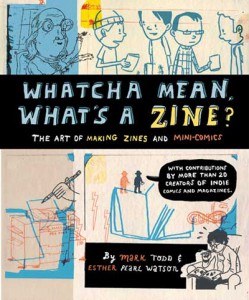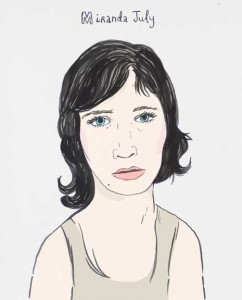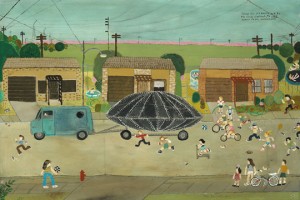At home in their shared Sierra Madre, Calif., artist studio, Esther Pearl Watson ILLU ‘95 and Mark Todd ILLU ’93 look every bit the part of one of those tightly knit couples whose lives intertwine both personally and professionally. They finish each other’s sentences. They share a cell phone, a car, and, up until recently, an email account. They have completed eight books together, and their paintings are (at least sometimes) shown in the same exhibitions (currently the Sandra Lee Gallery in San Francisco). Since 2003, they have co-taught in Art Center’s Illustration Department. For them, collaboration is a way of life, having spent most of their respective careers working side by side on projects, pushing the boundaries of illustration —whether through books for children, teens and adults, zines or illustrations. Success has followed: their work on the cover of American Illustration and clients like McSweeney’s, Business Week and Country Music Television.
“We’re a support system for each other,” said Todd. Added Watson, “We trust each other’s advice and rely on each other’s strengths. I’m the cheerleader with lots of ideas, and I trust Mark when it comes to art directing or refining the design or layout. We rely on this cross pollination of ideas.”
Their collaborative approach extends to their style of teaching. In their current TDS course, “Brand Monkey,” Illustration and Advertising students are being asked to develop concepts for a product and brand simultaneously. Some students came into the course with well-formed ideas, but Watson and Todd asked them to keep an open mind as they collaborate across the disciplines, because “that’s when something new is possible,” said Watson. “We try to keep it as real-world as possible. We always have to work with other people, whether an editor or designer on a book. Collaboration is the way of the future.”
What else does the future hold? Watson and Todd said much has changed since they were studying at Art Center in the early ‘90s. For Watson, illustrators today have tremendous opportunity and are less likely to be pigeonholed into one area. “We tell our students that what they graduate doing might not be what they do five years later,” she said. “They’ll evolve into something else, which is actually exciting. There’s a lot for today’s illustrators to explore.” Todd, meanwhile, expressed nostalgia for the earlier days, when careers were more clearly defined and it was easier to have fewer choices. “If you were interested in books, for example, you went into editorial illustration and moved to New York or Kansas to work at Hallmark. That was about it,” said Todd. “But now, there are so many other choices, and these worlds aren’t as stable.”
Perhaps the most notorious of these worlds is the publishing industry. On a recent trip to New York, Watson and Todd met with publishers who were looking for the next big thing, describing the mood as “kind of like the Wild West.” In particular, publishers were seeking print enhancements like interactive animations or illustrations in a digital format. According to Todd, publishers want someone who’s “very innovative in their thinking” and who isn’t going to approach publishing in a traditional way. “We encourage students to think beyond what’s been done and keep an open mind,” he said.
That doesn’t mean traditional books are disappearing, at least not yet. But Watson and Todd challenge students to develop projects in a broad range of media. As Watson explained, “Whether it’s through traditional books or making a line of toys, it’s still about storytelling.”
For the past three years, Todd and Watson have been teaching the highly popular “Illustration for Publishing” course, where the term ‘publishing’ is loosely defined as sequential images accompanied with print. “We teach anything from self-publishing (zines) and mini comics all the way up to working with major book publishers with a substantial advance and royalties,” said Todd. “Students have a lot of freedom. One assignment might be a reinterpretation of an existing text or song and then they can create whatever they want out of it—whether it’s a mini comic, a children’s book, an animation, a line of t-shirts or stuffed animals, even prints for an exhibition. Students are able to explore their own strengths and figure out what they do well that can be published in some form.”One of Todd’s favorite assignments is the recycle project, where he and his wife bring a large suitcase filled with stuffed animals or used books into class. Students are asked to choose an object and create a story around it. “They can tear the book apart and just use the design or the colors. They can actually use the physical book to make a new book. Or they can just read the story and there could be one sentence in the entire book that pops out and spurs an idea,” said Todd. “It’s basically a springboard to get them to think.”
Watson explained that the open nature of the course stems from their personal experiences. One of the main ways they receive commissions, she said, is by sitting in their studio, developing projects and pitching them. “There are a bunch of different directions we could pursue and different markets we could approach, and so it was critical to learn what we did well, including the stories we tell and our audience,” she said. Watson believes that if students are able to experiment with their own voice while at Art Center, then “it’s little easier when they’re sitting alone in their studio after Art Center asking, ‘Now what do I do to make money?’”
Regarding art world credibility, both Watson and Todd expect that the stigma against illustrators “crossing over” into the gallery world will continue to fade. Illustrators like Shepard Fairey, the Clayton brothers ILLU ’89 and ’91 or Mark Ryden ILLU ’87 have helped tear down some walls, while artists are shattering stereotypes in the other direction through commissioned album and book covers, billboards and advertisements. Watson and Todd are also part of this wave, having shown in art galleries themselves.
“Everything’s merging together. I don’t think you have to stay so segregated like you used to be,” said Watson, whose paintings have been shown at The Oakland Museum of California and Santa Monica’s Track 16 Gallery as part of the 3rd Annual LA Weekly Biennial. Her faux naïve style references Grandma Moses, but for Watson it comes from a real place. “These are meditations of my childhood— growing up in Texas where my father built flying saucers. There are very few photographs left from my youth, so in order to capture those memories I put it down as quickly as I can capture it. If I were to render it realistically, it would seem inauthentic to me.” She added, “I love confessional poetry—how the poet will say something so personal and take that risk. I try to do that in my paintings.”
In addition to her paintings, Watson works on a variety of book and zine projects, including her labor of love, Unlovable. This cringe-inducing, laugh-out-loud zine is based on a diary of a 15-year-old girl that Watson found in a gas station bathroom, Watson took the essence of the diary’s entries—all the desperate tales of trying to fit in during high school, the crushes, the bullying, the whining—and wove her own life into it. “She’s actually quite a lovable character, you know, trying on makeup for the first time and getting it wrong,” she said. “People come up to me and say, ‘Oh my god, that’s me!’” Now published by Fantagraphics Books, Watson will be holding a book signing of Unlovable Volume Two at Skylight Books on July 9. In August, Watson will do a book signing at Vroman’s in Pasadena for another recently published book, An ABC of What Art Can Be, published by Getty Publications.
Todd’s mixed media paintings are based on classic comic book covers and traverse the boundaries of Pop and high art. He is currently at work on “My Monster Notebook,” an illustrated book for Getty Publications about Greek monsters. He is also on the board of the upcoming ICON Conference for Illustrators, which is being held in Pasadena July 14-17. Art Center, a sponsor of the conference, is hosting a free cocktail party for all ICON attendees on July 15.
ICON has special meaning for Watson and Todd, since it was at the 2002 Conference in Philadelphia that they ran into then Illustration Chair David Mocarski (now Environmental Design Chair) who asked them if they wanted to move back to California from New York and teach in the Illustration Program. The rest is history.



![IMG_0008[1]](http://blogs.artcenter.edu/dottedline/wp-content/uploads/2010/06/IMG_000814-e1276801246710-225x300.jpg)








